Information for patients having an operation / procedure as an inpatient
Information for patients from Day Surgery
Contents
Having an operation as an inpatient (under a general or local anaesthetic)
About the consent form
You and your anaesthetic
How will my pain be managed?
Preventing a blood clot whilst you are in hospital
Pre-admission screening for surgical patients regarding MRSA
Day Surgery Helplines
Any complaints, comments, concerns, or compliments
Having an operation as an inpatient (under a general or local anaesthetic)
If you will be having a general anaesthetic or sedation
Please adhere to the following fasting instructions before your MORNING admission.
On the day of surgery, do not eat food after 2.30am. Please do not drink milk or juice with pulp after 2.30am. You may drink non-alcoholic clear fluids such as water or black tea / coffee until 6.30am. This does not include fizzy drinks.
Please adhere to the following fasting instructions before your AFTERNOON admission.
On the day of surgery, do not eat food after 7.30am. Please do not drink milk or fruit juice with pulp after 7.30am. You may drink non-alcoholic clear fluids such as water or black tea / coffee until 11.30am. This does not include fizzy drinks.
If under local anaesthetic without sedation you may take light refreshment up until coming into hospital.
Preassessment teams
Kent and Canterbury Hospital
Telephone: 01227 783114
Queen Elizabeth the Queen Mother (QEQM) Hospital
Telephone: 01843 235115
William Harvey Hospital
Telephone: 01233 616743
How can I prepare for my surgery?
While you wait for your surgery date, you can start preparing for your operation. Research shows that fitter patients, who are able to improve their health and activity levels before surgery, recover more quickly. Taking an active role in planning and preparing for your operation will help you:
feel in control
leave hospital sooner, and
get back to normal more quickly.
To help with this, you may be contacted by a member of the One You Kent (OYK) team. OYK work in the community, and help patients improve their general health. This includes help and advice on:
Stopping smoking
Losing weight
Getting more exercise
More information can be found on the following web sites.
One You Kent (Kent Community Health)
Fitter Better Sooner Toolkit (Royal College of Anaesthetists)
What will happen at my preassessment appointment?
Before the date of your operation, you may be asked to attend for preassessment. It is important to attend as failure to do so may result in your operation being cancelled.
You may be booked for a telephone preassessment. Please check your letter which will advise you either to attend or be available for a call.
At preassessment you will be seen by a nurse who will discuss your medical history with you and assess your fitness in preparation for your operation. The nurse will need to know:
any serious illness or major operations you have had
any allergies you have to medicines / metals, tablets, or plaster; and
any medicines / tablets you are taking; please bring them with you or bring a list of them.
On the day of surgery, please bring the following with you
Any tablets, medicines, or inhalers that you are taking in their containers. Do not bring controlled drugs.
Slippers or sandals or indoor shoes and a dressing gown.
Something to occupy you if you have to wait, for example a magazine, book, or mobile phone.
Mobile phones are now allowed.
A contact number for the person that is taking you home after your surgery.
Please do not bring
Any valuables or jewellery, as East Kent Hospitals cannot accept any liability for loss or damage of personal property.
Please do not wear contact lenses to the hospital on the day of surgery. You should make arrangements to wear glasses if you need them for normal use.
What should I do before the day of my operation?
Please ring the Waiting List Office or the unit where you are booked to attend (Surgical Admissions Lounge or Day Surgery Centre) as soon as possible if you will NOT be attending. This will allow us to offer the place to another patient.
If you develop a cough, cold, sore throat, other illness, or become pregnant, you must ring the unit where you are booked to attend (Surgical Admissions Lounge or Day Surgery Centre) to let them know.
If anything changes with your medical history please contact your preassessment team.
What happens when I arrive at hospital?
The photo’s in this booklet show the location of the Day Surgery Centres and Surgical Admissions Lounges.
After arriving at the Day Surgery Centre or Surgical Admissions Lounge, you will be seen by a nurse who will ask you further questions, take your pulse, blood pressure, and temperature.
You will have wristbands put on showing your identity and other details.
You may be asked to change into a cotton theatre gown and your dressing gown.
You may be seen by a member of the surgeon's team, who will ask further questions and examine you briefly. It is usual for the anaesthetist to speak to you briefly as well.
Where appropriate the site of the operation will be marked.
You will be asked to sign your consent form, if this had not already been done.
If you are having a general anaesthetic, the anaesthetist will put a small plastic tube (called a cannula) into a vein in your hand or arm. For further information about your anaesthetic, please go to the You and your anaesthetic section of this booklet.
Use this time to ask hospital staff any further questions or raise concerns. Please note you have the right to withdraw your consent for treatment at any time.
Smoking - please try not to smoke for at least 48 hours before your operation.
What should I do before surgery?
This will depend on the type of surgery you are having. You will be given the necessary information at your preassessment appointment.
What should I do to prepare for my operation?
Try to have a bath or shower at home before coming to the hospital.
Dress comfortably in loose fitting clothes.
Unless otherwise advised, take any regular medicine as usual on the day of your operation.
Please do not wear nail varnish, false nails, or make-up unless you have been advised otherwise by a doctor or nurse, as this may interfere with the monitors used during your anaesthetic.
What happens after my operation?
If you have a general anaesthetic you will be taken to the recovery room, which is next to the operating theatres, where you will be looked after by a recovery nurse. Whilst in the recovery area your blood pressure will be taken several times.
How will I feel after my general anaesthetic?
Some people may feel wide awake straightaway, while others feel sleepy for several hours. Some people may feel sick. If sickness is severe you may be given an injection to treat this. You may have a sore throat.
How soon after my operation can I fly?
Please advise the preassessment team of these plans so that the correct advice can be given.
If you have a general anaesthetic
Do not do any strenuous activities.
Do not operate machinery or do anything needing fine co-ordination or judgement, for example using a cooker, for at least 24 hours.
Do not make any important decisions or sign important documents for the first 48 hours after your operation.
You must not drive a car, or ride a motorbike or bicycle for at least 48 hours, unless advised otherwise by your doctor.
You may eat as you wish. However, your appetite may be poor to begin with, but you must drink plenty of fluids.
Do not drink alcohol or take sleeping tablets for at least 24 hours.
Follow the advice on the leaflets that you have been given.
Some people may feel emotional or "weepy" during the first few days; this is normal.
Channel Day Surgery Centre and the Surgical Admissions Lounge, William Harvey Hospital, Ashford
On turning into the hospital grounds, take the first left. This goes up pass the new Ashford One private hospital and staff car parks.
Follow the signs for the Channel Day Surgery Centre.
Go past the loading bay and you will see a glass fronted building (see below) with a car park opposite.
-1692173068.jpg)
Day Surgery, Queen Elizabeth the Queen Mother (QEQM) Hospital, Margate
Enter through the St Peter's Road entrance to the hospital (the old hospital entrance).
Use the pay and display car park at the St Peter's Road entrance.
Enter through the main doors at the St Peter's Road entrance, and go up the staircase opposite the entrance door. The Day Surgery reception is at the top of the stairs.
A lift is available along the corridor on your left, as you enter the St Peter's Road entrance.
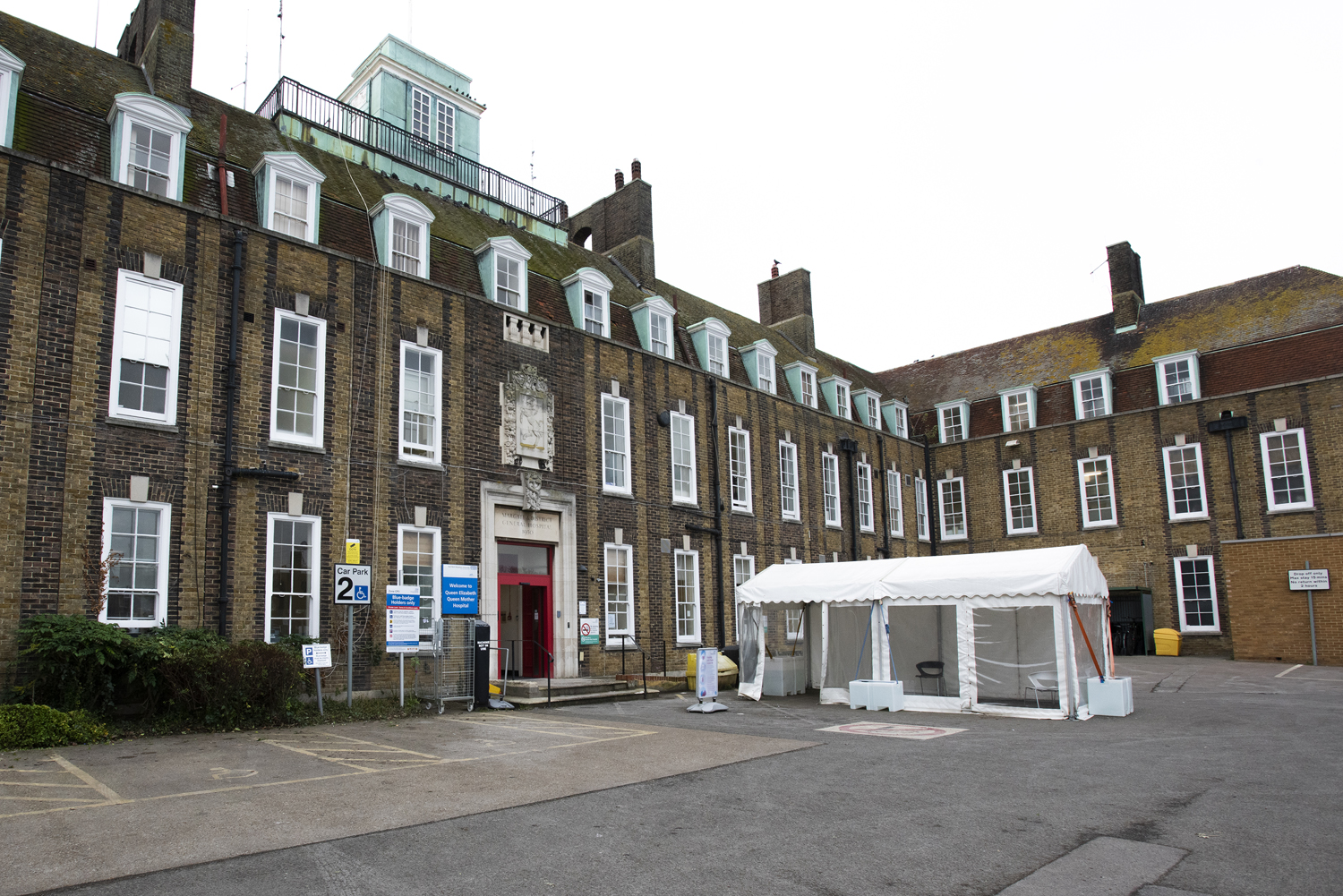
-
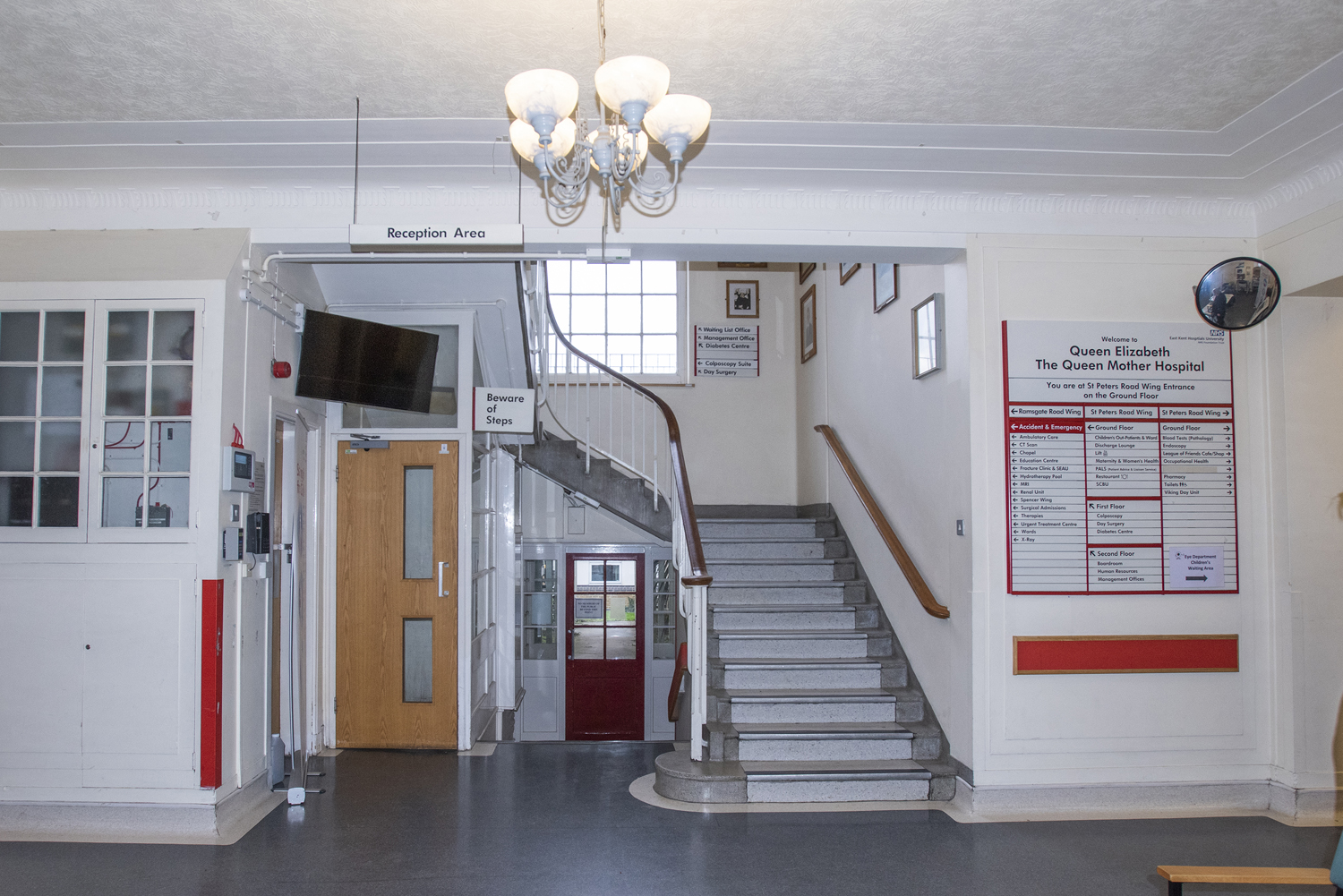 Stairs to Day Surgery
Stairs to Day Surgery -
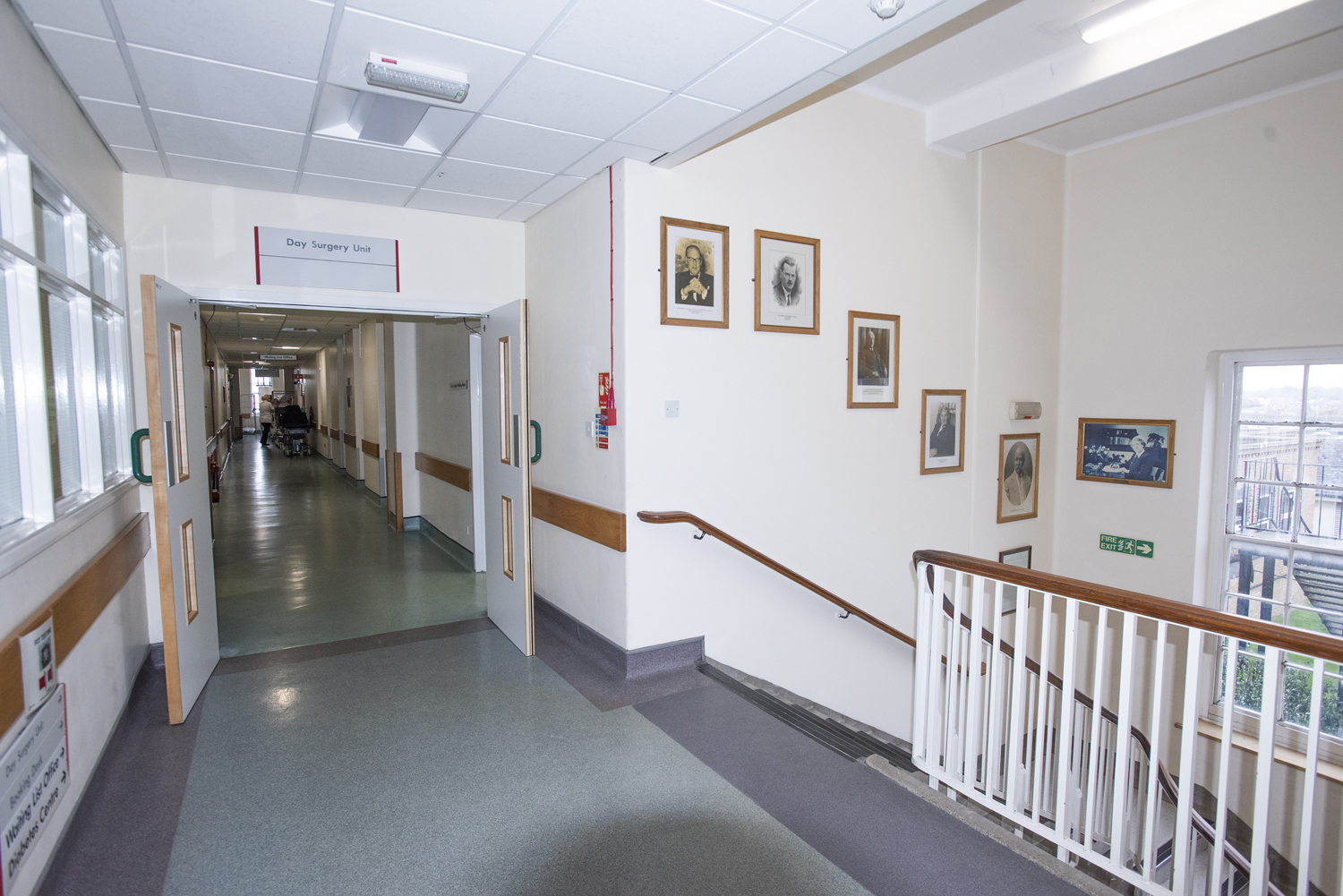 Day Surgery entrance
Day Surgery entrance
Surgical Admissions Lounge, QEQM Hospital, Margate
Enter through the Ramsgate Road entrance and follow the signs for the Surgical Admissions Lounge. If in doubt, ask a member of the reception staff for help.
-
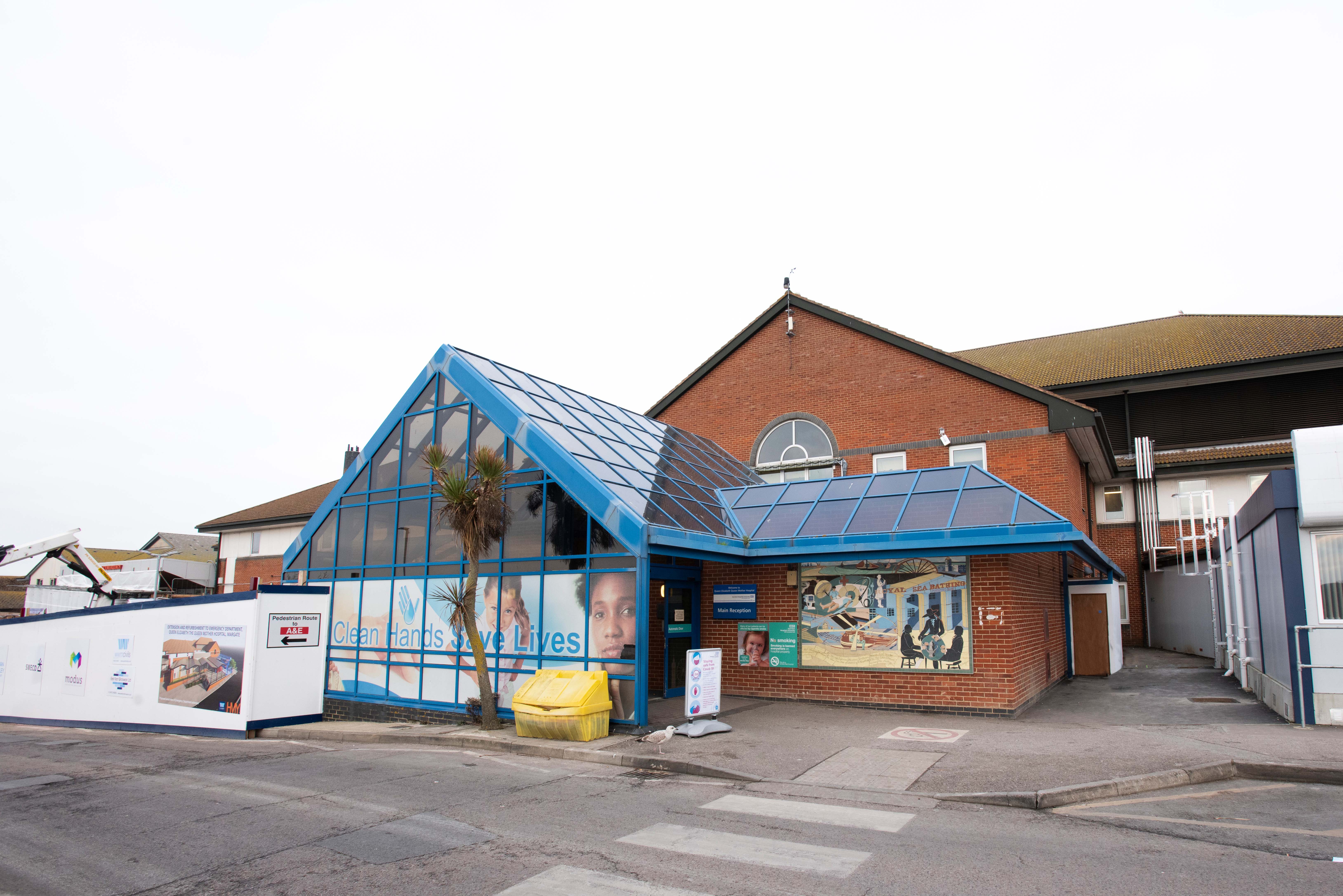 Ramsgate Road hospital entrance
Ramsgate Road hospital entrance -
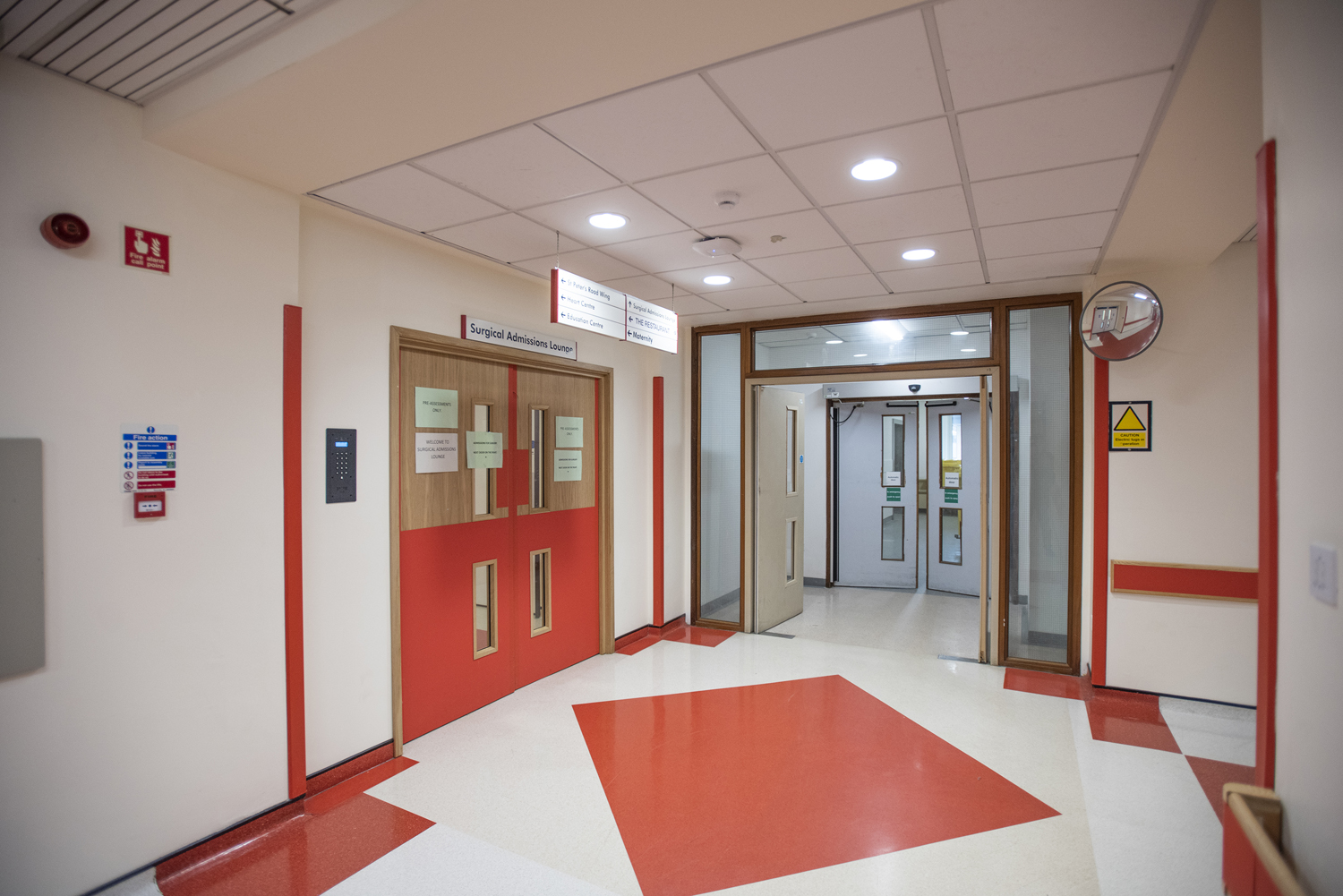 Surgical Admissions Lounge QEQM entrance
Surgical Admissions Lounge QEQM entrance
Canterbury Day Surgery Centre, Kent and Canterbury Hospital, Canterbury
Canterbury Day Surgery Centre has a set down and pick-up point next to the unit.
From Ethelbert Road turn into the gated hospital entrance. Continue along the road for 100 metres, the Day Surgery Centre set down point is on your right.
There is parking on the left as you enter through the gated entrance to the hospital, opposite the Canterbury Day Surgery Centre.
The Orthopaedic Centre is the same entrance as the Canterbury Day Surgery Centre.
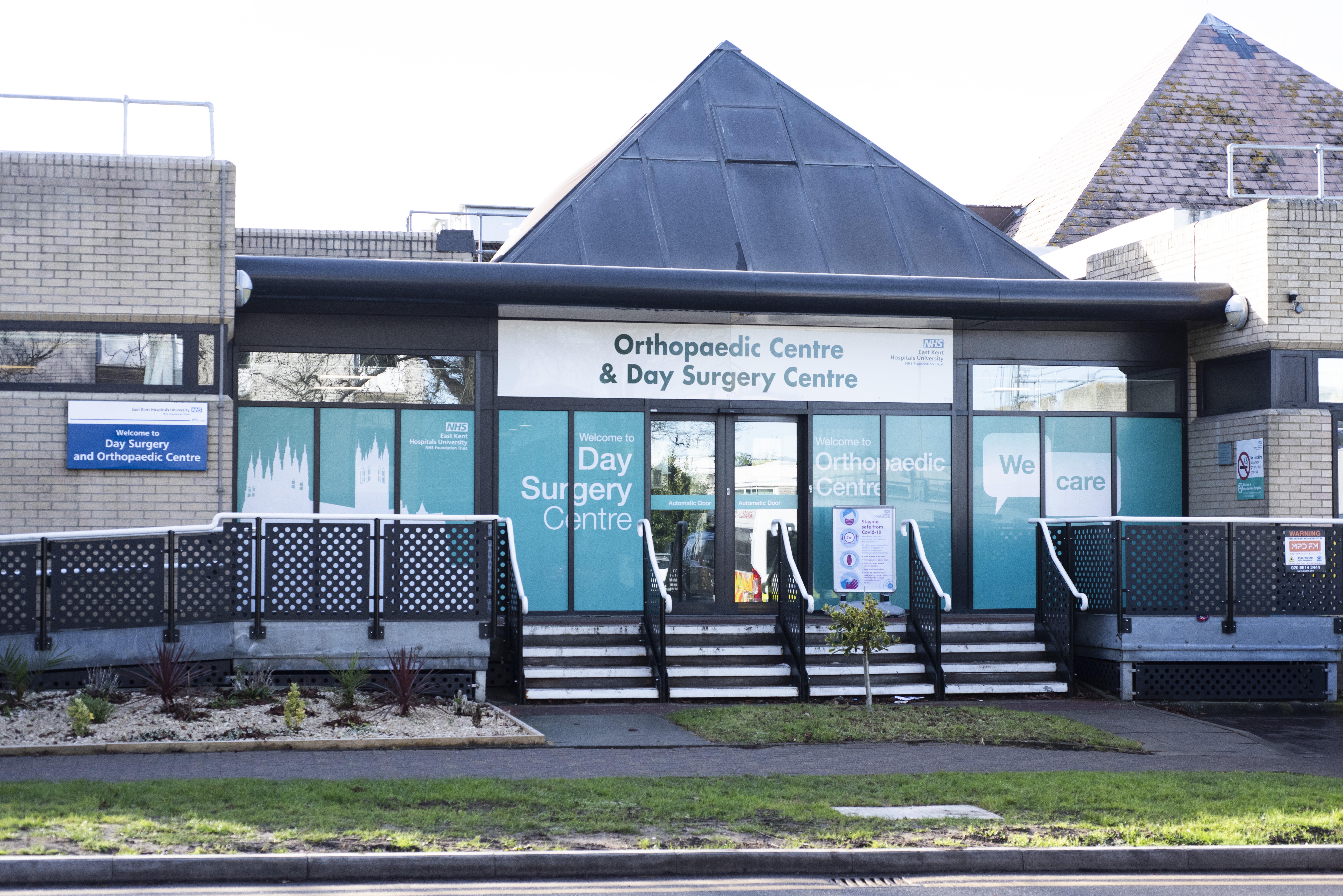
Surgical Admissions Lounge, Kent and Canterbury Hospital, Canterbury
Enter the hospital through the Fracture Clinic entrance, which is next to the the Urgent Treatment Centre. Follow the corridor to the end, turn left and the entrance to the Surgical Admissions Lounge is on your left.
-1692174181.JPG)
About the consent form
Why do I need to sign a consent form?
All patients must give permission before they receive any type of medical treatment, test, or examination. Consent is usually given when you sign the consent form before your treatment, but we may ask you to give it verbally.
You must give your consent voluntarily.
The hospital must give you all the information you need to make a decision about your treatment. This is so you can give us informed consent. If you have not been given this information, or you have but you still have questions, please speak to a member of staff.
You must be capable of giving consent. This means that you understand the information given to you and can make an informed decision.
When we ask you to give consent, please use this time to ask any questions you may still have. For more information, please go to the NHS Consent for Treatment web page. Remember, you can withdraw your consent for treatment at any time.
You and your anaesthetic
(Author: Royal College of Anaesthetists and Association of Anaesthetists, 6th edition April 2023)
This section gives information on what to expect when having surgery with anaesthesia. It has been written by anaesthetists working together with patients and patient representatives. It also shows you where to find other information that might be helpful.
What is anaesthesia?
Anaesthesia stops you feeling pain and unpleasant sensations. It can be given in various ways and does not always mean that you are asleep.
There are different types of anaesthesia, depending on the way they are given:
Local anaesthesia involves injections that numb a small part of your body and are normally used for relatively minor procedures. You stay conscious but free from pain. This is commonly administered by the surgeon undertaking the operation.
Regional anaesthesia (for example, a spinal, epidural or nerve blocks) involves injections that numb a larger or deeper part of the body. You stay conscious or receive some sedation, but are free from pain. For some surgery you may be aware of pressure sensations.
General anaesthesia is medication that gives a deep sleep-like state. It is essential for some operations and procedures. You are unconscious and feel nothing. Drugs for a general anaesthetic are usually given into a vein or breathed in as a gas, or a combination of both.
Sedation is medication that makes you feel sleepy and relaxed. You will not be completely asleep and you may be aware of your surroundings.
Sedation is often used with a local or regional anaesthetic. Sedation may be light or deep depending on the procedure and you may remember everything, something or nothing after sedation.
More information on the different types of anaesthetics can be found on our website.
About anaesthetists
Anaesthetists are doctors with specialist training who:
discuss with you the types of anaesthetic that are suitable for your operation
if there are choices available, will help you choose and discuss the risks, benefits and alternatives with you
agree a plan with you for your anaesthetic and pain control afterwards
give your anaesthetic and are responsible for your safety and wellbeing throughout your surgery and in the recovery room.
You may also meet other highly trained healthcare professionals. Read more about these roles and the anaesthesia team on our website.
Meeting your anaesthetist
You may meet with an anaesthetist at the preassessment clinic. Otherwise, you will meet your anaesthetist in the hospital on the day of your surgery. They will discuss the type of anaesthetic you can have, including benefits, risks and your preferences, and you will decide together which anaesthetic is best for you.
However, not all types of anaesthetic are appropriate for all types of operations.
If there is a choice of anaesthetic, the decision on which to use will depend on:
the operation you are having
any medical problems and your specific risks
your preferences and the reasons for them
the recommendation and particular skills of the anaesthetist
the equipment, staff and resources at the hospital.
Risk and shared decision-making
Modern anaesthetics are very safe. There are some common side effects from the anaesthetic drugs or the equipment used, which are usually not serious or long lasting. Risks will vary between individuals and will depend on the procedure and anaesthetic technique used.
Your anaesthetist will discuss with you the risks that they believe to be more significant for you. They will only discuss less common risks if they are relevant to you.
You can read more detail about risks associated with anaesthesia here.
Shared decision-making
Shared decision-making ensures that individuals are supported to make decisions that are right for them. It is a collaborative process through which a clinician supports a patient to reach a decision about their treatment.
The conversation brings together:
the clinician’s expertise, such as treatment options, evidence, risks and benefits
what the patient knows best: their preferences, personal circumstances, goals, values and beliefs.
Find out more on the NHS England website.
Questions you might like to ask
If you have questions about your anaesthetic, write them down (you can use the examples below and add your own). If you want to speak to an anaesthetist before the day of your operation, contact the preoperative assessment team who may be able to arrange for you to speak to an anaesthetist on the telephone or see them in a clinic.
Preparing for the operation
Fitter patients who are able to improve their health and lifestyle recover from surgery more quickly and with fewer complications.
There is much you can do to prepare yourself for an operation. Even small changes can make a big difference. You might want to increase your levels of physical activity and improve your diet. If you drink or smoke, you should consider cutting back or even stopping.
If you have a long-standing medical problem, check with your GP surgery whether there is anything you can do to improve it well ahead of the surgery.
Our Fitter Better Sooner resources will provide you with the information you need to become fitter and better prepared for your operation. Please see our website for more information.
When you are called for your operation
A member of staff will go with you to the theatre.
You can usually wear your glasses, contact lenses and hearing aids, and dentures until you are in the anaesthetic room. You may be able to keep them on if you are not having a general anaesthetic.
If you are having a local or regional anaesthetic, you may be able to take your own electronic device, with headphones to listen to music (check with your nurse beforehand).
You may walk to theatre, accompanied by a member of staff, or you may go in a wheelchair or on a bed or trolley. If you are walking, you can wear your own dressing gown and slippers.
Routine checks will be done as you arrive in the operating department before the anaesthetic starts. You will be asked your name, your date of birth, the operation you are having, where on your body you are going to have the surgery, when you last ate or drank and if you have any allergies. These checks are routine in all hospitals.
Starting the anaesthetic
Your anaesthetic may start in the anaesthetic room or in the operating theatre. Your anaesthetist will be working with a trained assistant. The anaesthetist or the assistant will connect monitors to measure your heart rate, blood pressure and oxygen levels, and any other equipment as required.
A cannula, a thin plastic tube, will be inserted in a blood vessel on the back of your hand or arm. This will be used to give the anaesthetic and any other drugs required during and after surgery. If you are feeling anxious about having a cannula inserted, you may be able to have a local anaesthetic cream to numb the area.
General anaesthetics
Anaesthetic drugs are injected into a vein through the cannula. This method is generally used to start the anaesthetic and also to give other medications during surgery. You may also be given oxygen through a mask.
After you are asleep, a breathing tube will be inserted to give oxygen and anaesthetic gases if required. The breathing tube will be removed before you wake up.
More information is available in the leaflet Your airway and breathing during anaesthesia.
Regional anaesthetics
If you are having a regional anaesthetic, the following will happen:
your anaesthetist will ask you to keep still while the injections are given. They may use a special ultrasound machine to place the local anaesthetic. You may notice a warm tingling feeling as the anaesthetic begins to take effect
your operation will go ahead only when you and your anaesthetist are sure that the area is numb. They will do several tests to make sure that the anaesthetic is working
you will remain alert and aware of your surroundings, unless you are having sedation. A screen will stop you seeing the operation unless you want to and the theatre team agrees that you can watch
a member of the anaesthetic team is always near to you and you can speak to them whenever you want
you may also be able to listen to music with headphones during the procedure.
The recovery room
After the operation, you will usually be taken to the recovery room, a special ward close to the operating theatre where you will be closely monitored as you recover from the anaesthetic. Recovery staff will make sure that you are as comfortable as possible and give any extra medication that you may need. When they are satisfied that you have recovered safely from your anaesthetic and there is a bed available, you will be taken back to the ward.
Pain relief after surgery
For information on how to manage your pain when you return home, please see How will my pain be managed? below.
How will my pain be managed?
How much pain will I have?
The amount of pain you feel will depend on many things such as the kind of operation, injury, or illness you have. A certain amount of pain or discomfort may be expected and it is usually not possible to relieve all pain. As healing takes place the level of pain should reduce. Our aim is to provide enough pain relief to make you comfortable and prevent complications.
Is pain relief important?
Yes. As well as making you more comfortable good pain relief may help you to recover more quickly. If you are comfortable you will be able to take deep breaths, cough, and sleep better. Also if you are able to move around you are less likely to get blood clots in your legs. Please do not be tempted to cope by lying still, taking only shallow breaths, and not coughing as this may (in a short time) cause a chest infection.
So please, do let the ward nurses know if you are in pain so that it can be treated.
How will my pain be managed?
Your doctor and nurse will discuss a plan for managing your pain with you that is suited to your individual needs. You should let them know if you already take regular painkillers or have had problems with painkillers in the past, such as allergies or stomach upsets.
Painkillers will be prescribed to be given regularly or when you tell your nurse that you are in pain. The nursing staff will assess your pain regularly and will ask you if the pain you feel is mild, moderate, or severe. The Pain Assessment Score we use is shown below.
0 = No pain
1 = Mild pain
2 = Moderate pain
3 = Severe pain
What painkillers might I be offered?
Painkillers may be given by mouth (oral), injection, suppositories, Patient Controlled Analgesia (PCA) pump, epidural infusion, or nerve block. You may be prescribed a combination of painkillers as research shows this may give better pain relief.
Tablets, capsules, or liquids
This is the most common way of giving pain relief provided you are able to eat and drink and do not feel sick. Painkillers given by this route will take at least 30 minutes to work.
Injections
This is another method of giving pain control, used particularly after some types of surgery. A painkilling drug is injected via a needle into a muscle - usually in the leg but the buttock may sometimes be used. Injections may take about 20 minutes to work.
Suppositories
This is a useful way of giving painkillers if you are unable to swallow, feel sick, or are vomiting. The suppository is inserted into the back passage (rectum) and is gradually absorbed by the body.
Patient Controlled Analgesia (PCA)
Analgesia is the absence or relief of pain. With PCA you control the amount of a strong painkilling drug such as morphine that you give yourself. A PCA Pump is programmed by your anaesthetist or nurse and when you press a hand held button a small dose is delivered into a vein via a drip. No further doses will be released until a set time has passed (usually five minutes) so it may take some time to achieve the level of pain relief you want.
You will be taught how to use the pump by the nurses or doctors.
While you are using PCA the nurses will monitor you regularly to check for side effects and to assess if the PCA is relieving your pain.
It is important that no one but you presses the PCA button.
Epidural
The nerves from your spine to your lower body pass through an area in your back close to your spine called the epidural space. Your anaesthetist will insert a fine plastic tube (epidural catheter) into this space. This is then connected to an epidural pump and painkilling drugs are continuously dripped in.
Two types of drug are usually given together, a local anaesthetic and a morphine like drug. The local anaesthetic may cause numbness as it blocks the nerve messages but feeling returns when the epidural is stopped.
The epidural may be kept in for up to four days. More information is available in the leaflet Epidural anaesthesia during and after surgery.
If your anaesthetist thinks this is the best method of pain relief for you, the procedure will be discussed with you and your agreement sought.
Local Anaesthetic Nerve Block
Local anaesthetic may be injected into or around your wound to block pain. This may be given as a ‘once only’ dose which can last for several hours. Sometimes your anaesthetist will place a fine catheter to give a continuous infusion or further injections of local anaesthetic. The catheter may be left in place for a few days.
Will I suffer any side effects?
All drugs including painkillers may cause side effects in some people. Painkillers may cause sickness, constipation, drowsiness, dizziness, itchiness, and confusion. If epidural or nerve block is used for pain control, sensations of weakness, numbness, or ‘pins and needles’ may be felt.
Please tell your nurse or doctor if you experience side effects. Your painkiller may need to be changed or medication given to treat any side effects.
Some people worry that they will become addicted if they take strong painkillers. When used appropriately for a short time this is very unlikely.
You may go home on morphine-type painkillers following your operation. It is important that you reduce and then stop these medications as soon as possible as their continued use can cause you significant harm.
When should I have painkillers?
Research shows that taking painkillers regularly provides better pain relief as the level of drug in your body remains more constant. We would advise you not to try and do without your painkillers unless you are comfortable and able to take deep breaths, cough, and move about.
Please do not wait until your pain is severe before asking for painkillers.
You do not have to wait until the drug round is due.
What can I do to help myself?
Try to take at least three deep breaths every half an hour unless instructed otherwise by your physiotherapist.
Try to cough and clear your chest.
When you cough, support your wound by placing your hands or a folded towel over it. The physiotherapist or nurse can show you how to do this.
Try to sit up and move about a little (provided your operation or injury does not prevent this).
What else can I do to help myself?
Regular periods of relaxation are very beneficial as they reduce anxiety and ease muscle tension which can reduce your pain. Also, distracting your attention away from your pain can make pain more bearable.
Reading, listening to music, watching television, chatting to fellow patients, or doing crosswords are just a few distraction suggestions.
The following relaxation tips may help.
Close your eyes, place your hand on your abdomen and slowly breathe in through your nose to the count of four feeling your abdomen rise.
Hold your breath briefly and then breathe out through your mouth to the count of four.
Repeat this cycle of breathing slowly in and out for a few minutes.
Place your arms by your side and relax your shoulders. Close your eyes and breathe slowly and deeply.
Focus on tensing and relaxing each set of muscles in your body in turn. You may start from your head and work downwards or from your toes and work upwards.
Avoid areas which have undergone recent surgery or injury.
How will my pain be managed when I go home?
You may be given some painkillers to take at home. Your nurse will explain how and when these should be taken. If you need more painkillers or your pain worsens you should contact your GP.
Where can I get more information?
Preventing a blood clot whilst you are in hospital
This section discusses the risks of having a blood clot whilst you are in hospital. It outlines what you and your doctor can do to reduce this risk
What are deep vein thrombosis (DVT) and pulmonary embolism (PE)?
Deep vein thrombosis (DVT) is the name given to a blood clot which forms inside a vein. It usually develops in the deep veins of the leg, and blocks the flow of blood. This can cause the leg to become painful and swollen.
Pulmonary embolism (PE) occurs when a fragment of blood clot in a leg breaks loose. It then becomes lodged in a blood vessel in the lungs. This is a potentially serious condition. It can cause pain, breathlessness, and a lack of oxygen in the blood.
Together, deep vein thrombosis and pulmonary embolism is known as venous thromboembolism or VTE.
Am I at risk of developing VTE whilst in hospital?
As part of your admission to hospital your healthcare professional will consider a series of questions. These questions are about factors that are linked with the development of VTE.
Questions they may ask you
Are you aged over 60 years?
Are you overweight?
Do you have cancer?
Are you pregnant?
Are you taking the contraceptive pill or hormone replacement therapy (HRT)?
Have you had venous thrombosis in the past?
Are you known to have a clotting tendency (thrombophilia)?
Has anybody in your close family had venous thrombosis?
Do you have any kidney diseases, such as the nephrotic syndrome?
Do you have any bowel disorders, such as inflammatory bowel disease?
What can I do to reduce my risk of developing VTE?
Try to do the following before your planned admission to hospital.
Eat a balanced diet and keep well hydrated by drinking plenty of water.
Keep mobile, move around as much as possible in the weeks before your surgery.
Take care on journeys. If you can, avoid uninterrupted journeys of over three hours in the month before your surgery.
If you do need to make a long journey, try to move your legs regularly. If travelling by car, take a break and walk around every two hours.
Talk to your doctor if you are taking the contraceptive pill or HRT. These medicines may increase your risk of DVT or PE.
What happens when I arrive at the hospital?
Your clinical team will assess your risk of VTE. The team will discuss with you what will be done to reduce your risk of developing a VTE.
The risk assessment will be done as soon as possible after you come into hospital. If you are having a planned procedure, it will be done at your pre-assessment appointment.
The nurse or doctor carrying out the assessment will ask you about all the risk factors listed above. These are your individual risk factors.
They will also look at:
the nature of your current illness
how long you are likely to be in hospital; and
whether you will be having any surgery.
The type of surgery you have will also determine the treatment you have to reduce your risk of VTE.
What treatment will I be given to reduce my risk of VTE?
The treatments recommended for you will depend on the result of your risk assessment. Your doctor will discuss your options with you before any treatment begins. These may include the following.
Medication
You may be given medicine to stop your blood from clotting too quickly. These are called anticoagulants. You may be treated with:
- heparin injections, such as enoxaparin; or
- anticoagulants taken in tablet form, called rivaroxaban or apixaban.
For patients already taking an anticoagulant, such as warfarin. Your doctor will talk to you about what anticoagulation treatment is suitable for you while you are in hospital.
Some heparins contain animal products. If you are concerned about having animal products, please let your doctor know.
Anticoagulants can increase your risk of bleeding. Please discuss with your doctor what to look out for.
Special stockings
These are called anti-embolism stockings (AES). They reduce the risk of DVT by reducing swelling and preventing blood from collecting in the veins.
Anti-embolism stockings are not recommended for people who have:
poor circulation (peripheral vascular disease)
loss of feeling in their lower legs (neuropathy)
leg ulcers
had a recent skin graft
extreme deformity of their legs
very swollen legs; or
have had an acute stroke.
Let staff know if you have any skin allergies.
How are anti-embolism stockings fitted in hospital?
AES should be fitted, so before wearing stockings staff should take your measurement for below knee stockings and thigh measurement if measuring for thigh length stockings.
Measuring for correct stocking size
-
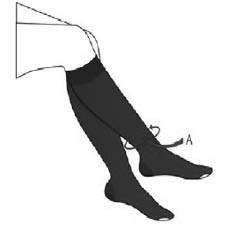 Around your ankle (below knee stockings)
Around your ankle (below knee stockings) -
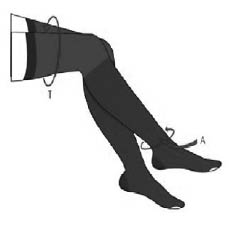 Upper thigh (thigh length stockings)
Upper thigh (thigh length stockings)
How do I put my stockings on?
Check the stocking is not inside out.
Insert your hand into the stocking as far as the heel pocket.
Firmly grasp the centre of the heel pocket. Keeping hold of the heel, turn the stocking inside out to the heel area.
Grasp the excess stocking at the front of your foot.
Put the stocking over your ankle and ease the fabric up your leg. Do not drag the stocking against your skin (steps 1 to 4 below).
-
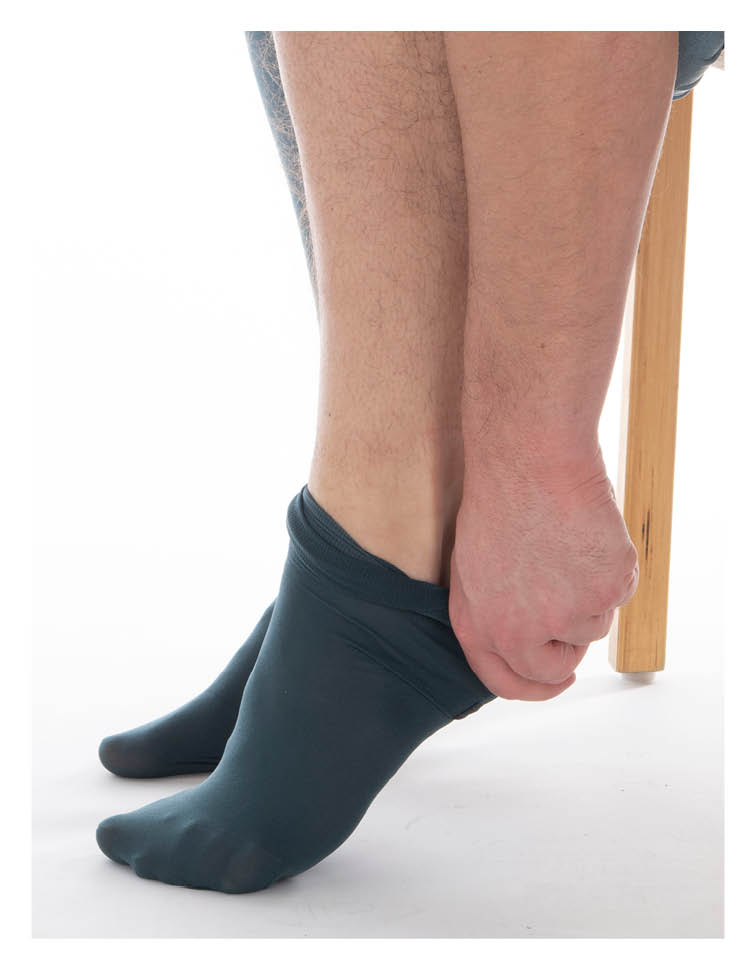 Step 1
Step 1 -
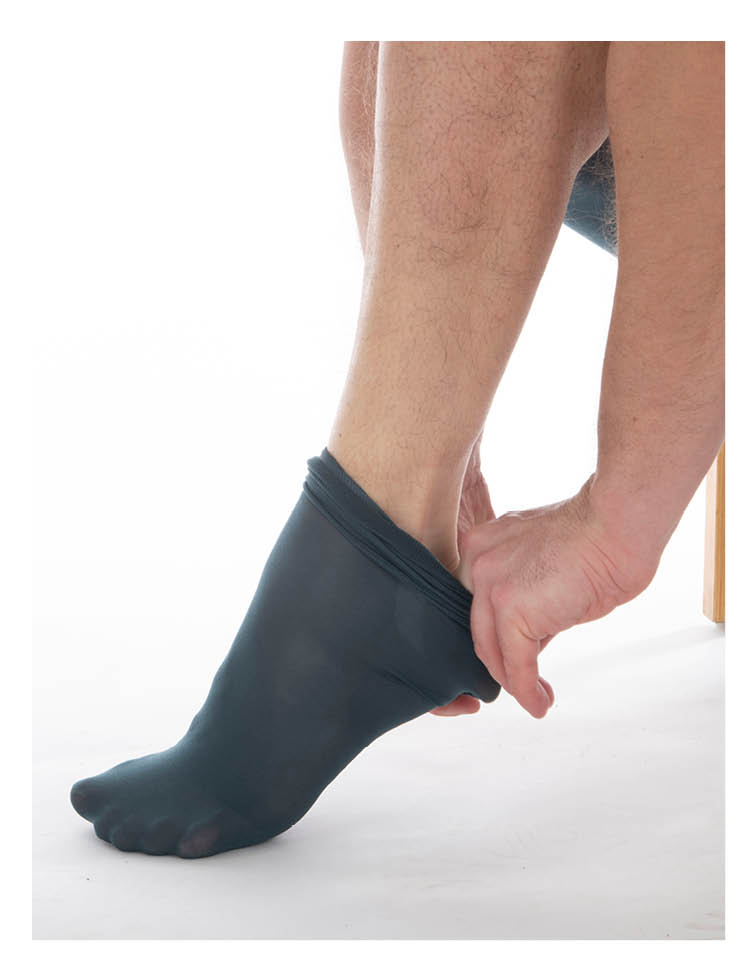 Step 2
Step 2 -
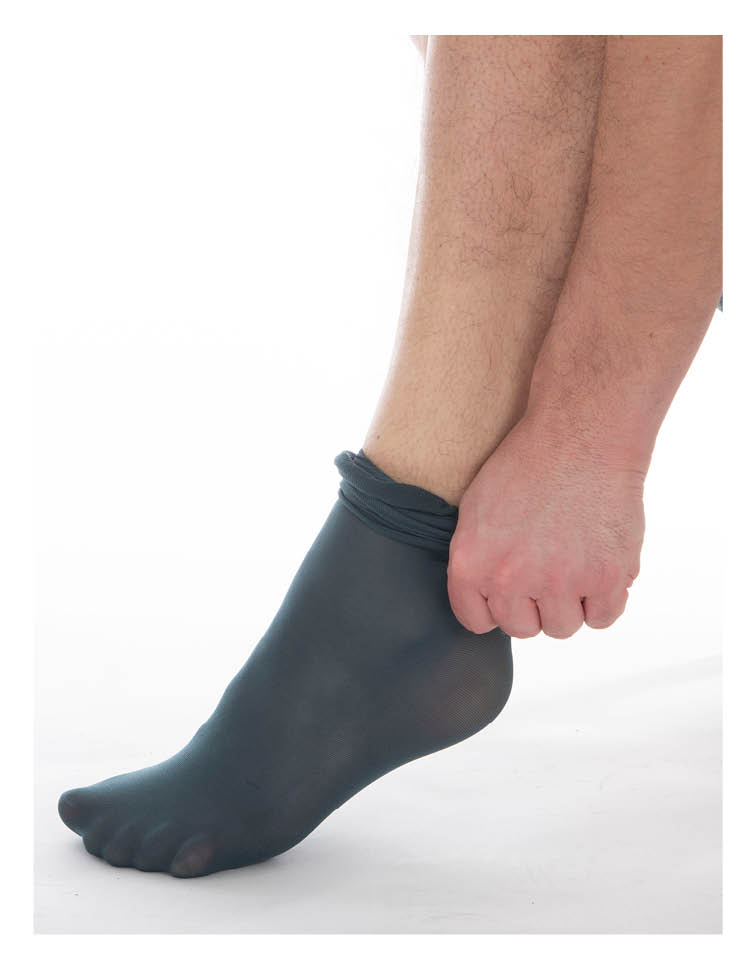 Step 3
Step 3 -
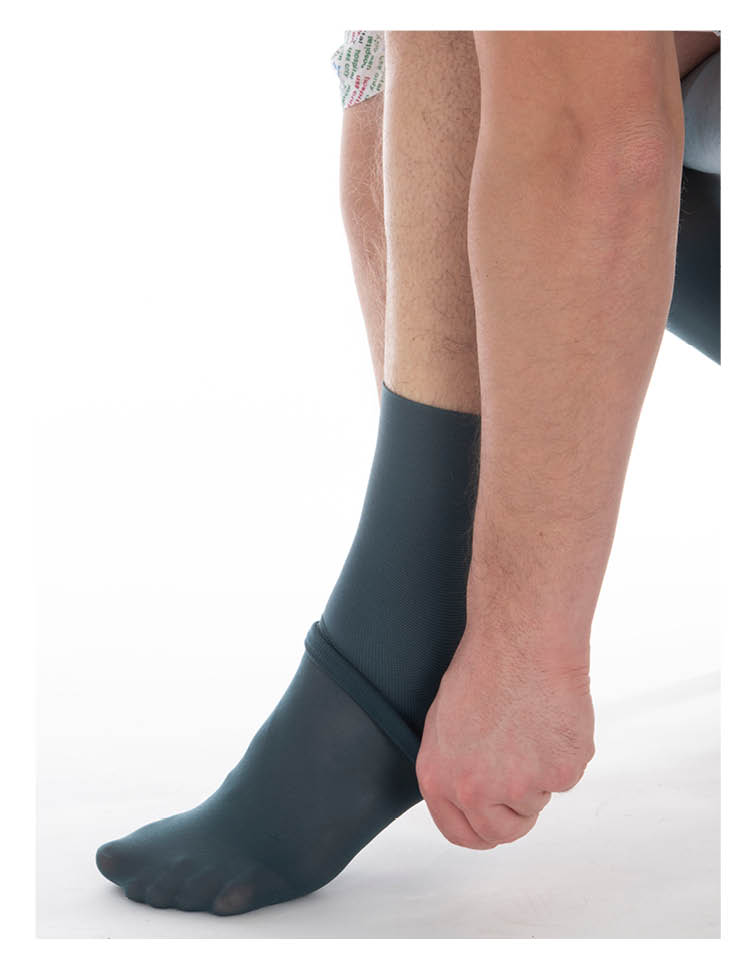 Step 4
Step 4
Pull the open toe section of the stocking forward. Doing this will smooth out any excess material causing creases in your foot.
Make sure your toes are covered. The open section is comfortably placed under your toes.
Do not push your toes through the open toe area.
-
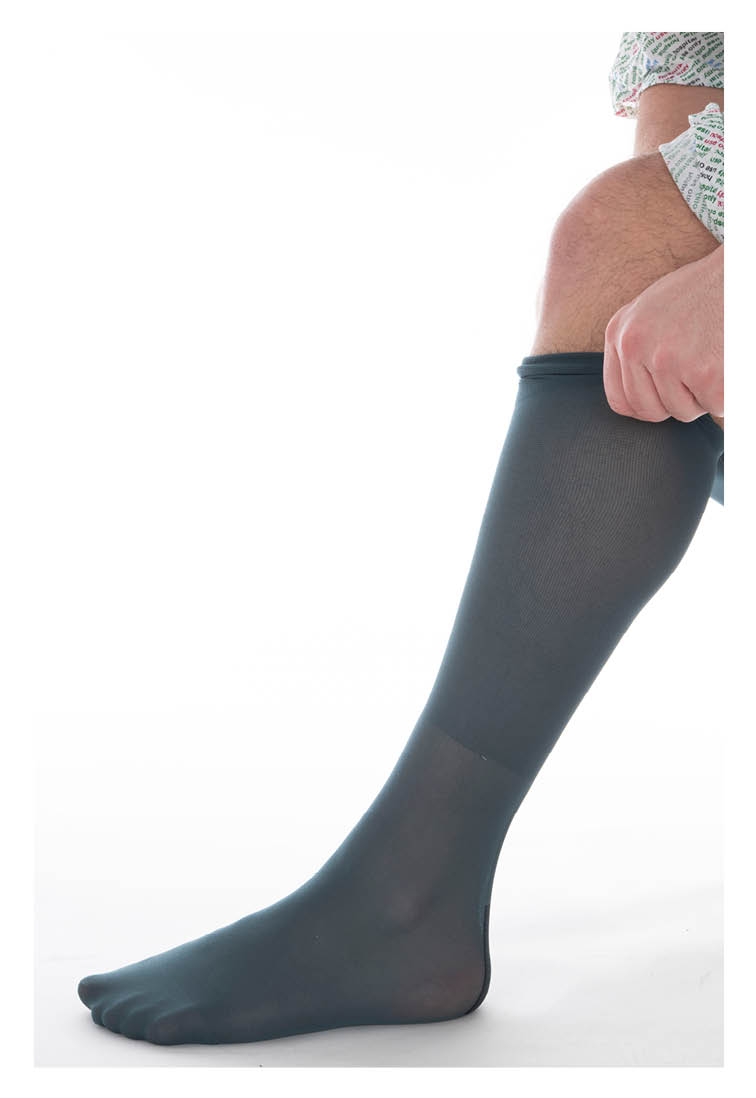 Step 5
Step 5 -
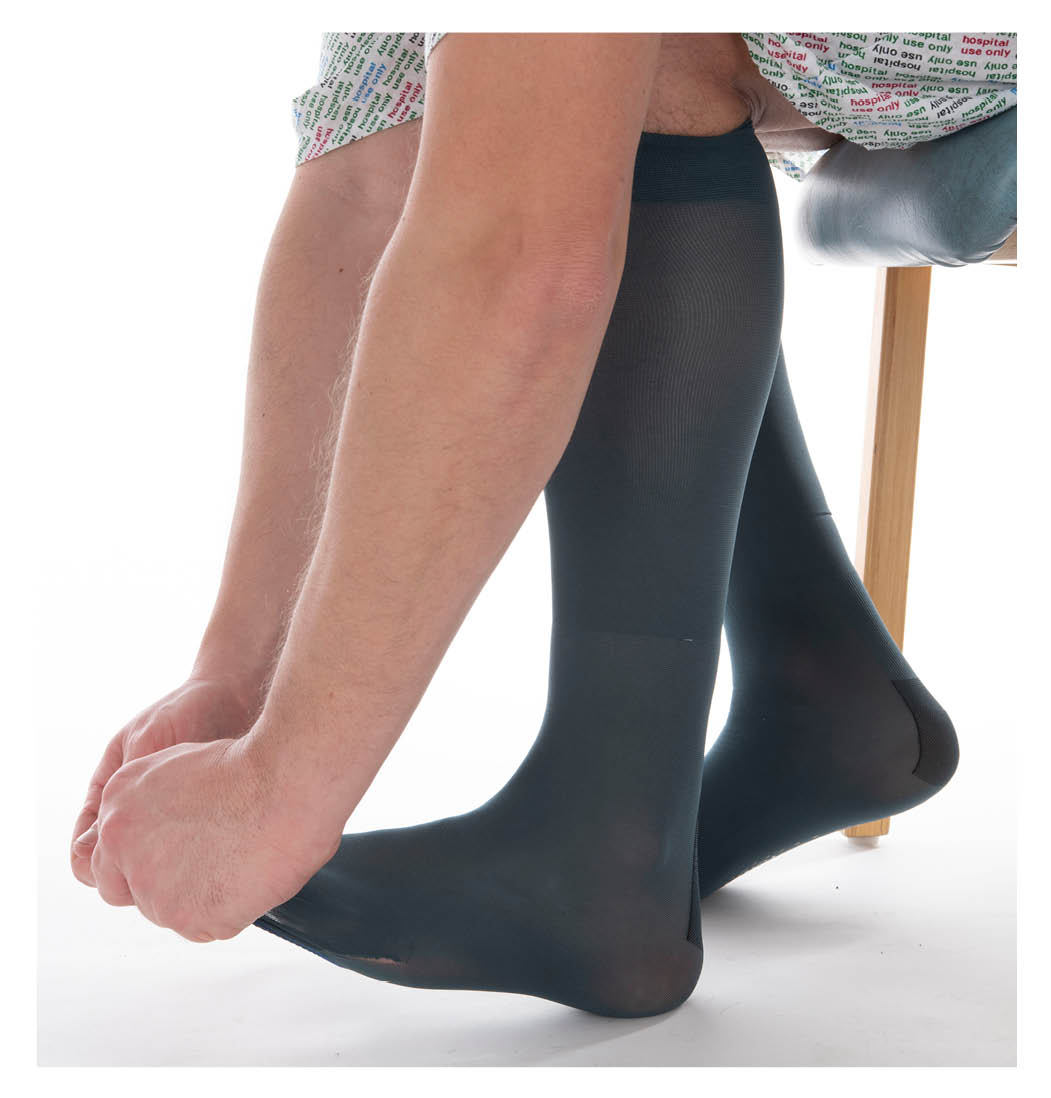 Step 6
Step 6 -
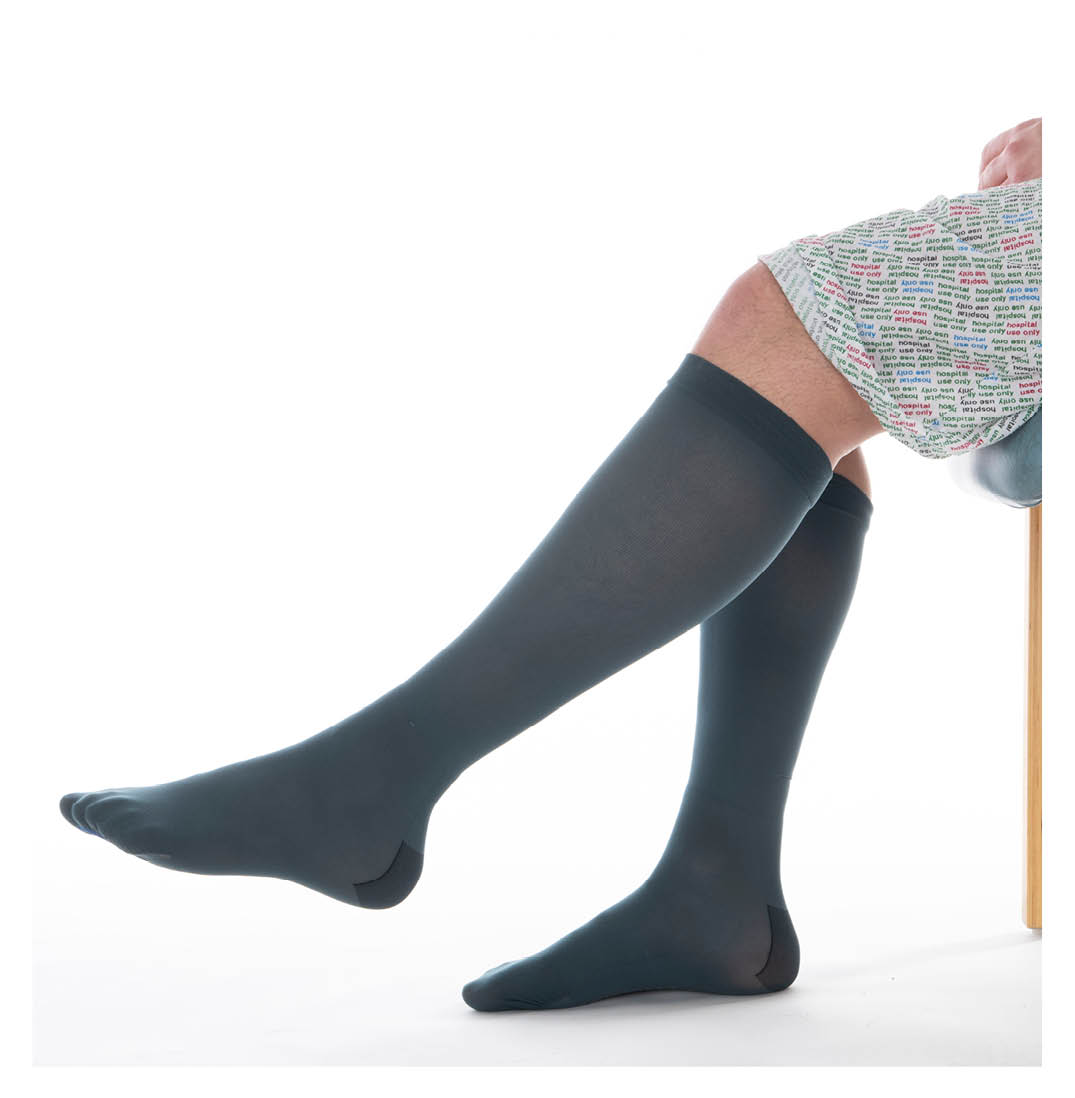 Step 7
Step 7
Pull the stocking up over your calf. Make sure you smooth out any wrinkles that appear, and that the band at the top is smooth and not rolling over.
Make sure the stocking finishes two fingers width down the back of your knee joint. This is important for blood flow.
It is important not to roll the stocking down your leg or to fold the toe section back on itself. This can reduce the blood flow in your legs and put you at risk of developing a blood clot in your leg.
Special points to note about your stockings
Stockings should be worn throughout the day and night to be most effective.
Remove your stockings daily. When removed, you can wash your skin and check your heels and other pressure points for sore or broken areas. Do not leave them off for longer than 30 minutes, as this may reduce their effectiveness.
Make sure that your stockings are wrinkle free and not rolled down, as this may restrict the blood supply to your leg.
Do not apply oil products to your legs, as they may damage the fabric of the stockings. Use emollients such as aqueous cream if your skin is very dry, but you must make sure it is well rubbed in. Emollients are moisturising treatments added directly to the skin to soothe and hydrate it.
Tell a member of staff immediately if you experience any of the following in your legs whilst wearing the stockings.
Tingling
Numbness
Pain
Blistering
Redness.
How do I remove my stockings?
Pull down from the top of the stocking, down your leg and then over your heel and foot. This will leave the stocking inside out. Turn the stocking back to its right side before refitting.
3. Foot or leg pumps
These are called intermittent pneumatic compression (IPC). They reduce the risk of DVT by gently compressing your leg. This increases blood flow and stops blood pooling in your leg to create clots.
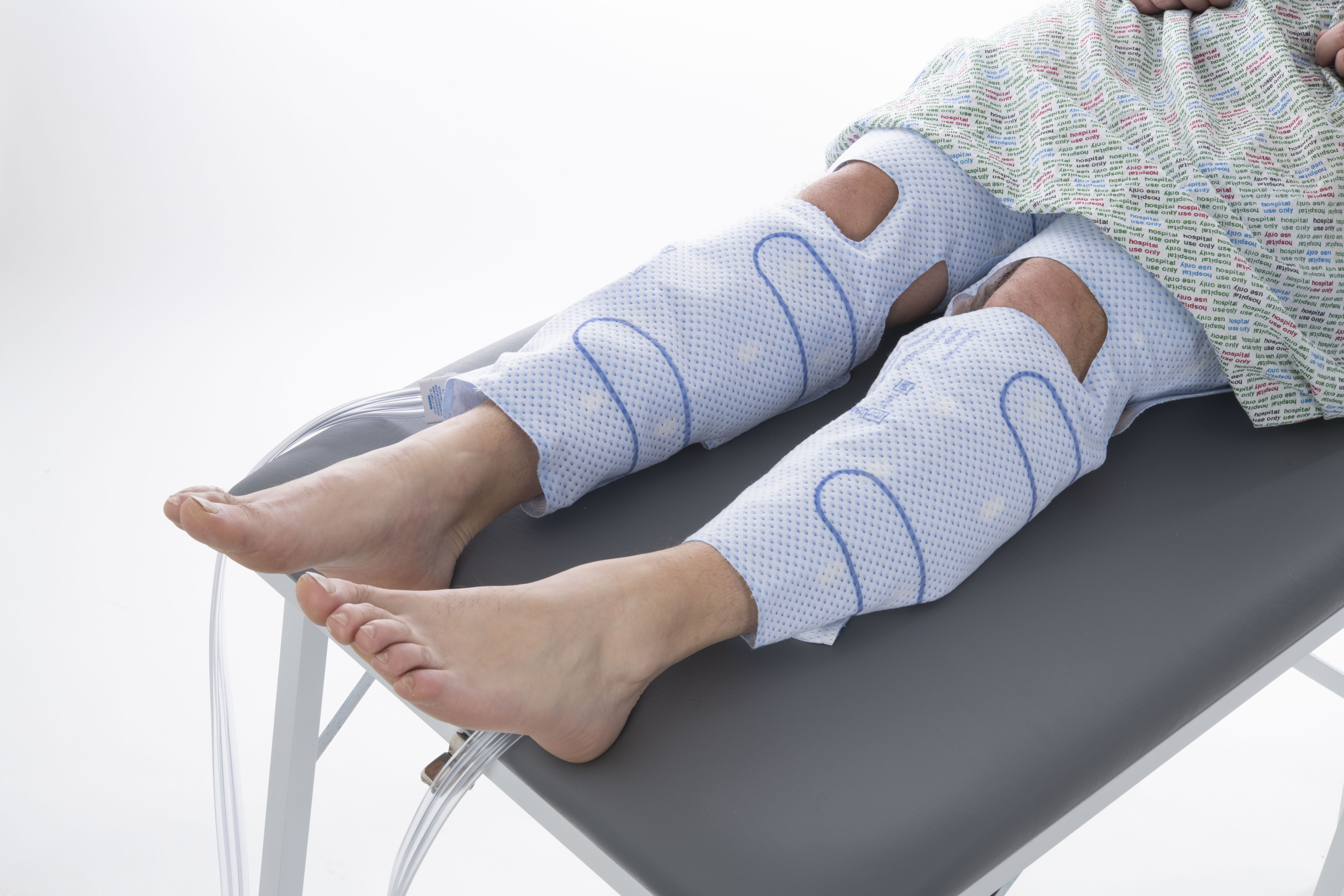
IPC sleeves are not recommended for people who have the following.
Acute or suspected DVT or PE.
Severe peripheral vascular disease.
Severe skin problems on their legs.
Massive oedema of the legs or pulmonary oedema from congestive heart failure.
Peripheral neuropathy.
Unusual leg size, shape, or deformity preventing a correct fit.
Your legs should be measured before fitting, to make sure the correct size sleeves are used. The sleeve should fit snugly round your leg or foot but you should still be able to get two fingers under it.
Special points to note about foot or leg pumps
Sleeves should be worn 24 hours a day.
Sleeves should be removed daily for bathing and to check your skin.
Please check your sleeves are inflating regularly and are not switched off.
Let staff know if the sleeve feels either too loose or too tight.
Tell a member of staff immediately if you experience any of the following in your legs whilst wearing the sleeve.
Tingling
Numbness
Pain
Blistering
Redness.
How can I help myself while in hospital?
Try to move around as much as possible while in hospital. This is particularly important after surgery.
Do not sit or lie with your legs crossed. If possible, make a point of wriggling your feet regularly.
Do not become dehydrated. Please ask your nurse about how much you should be drinking.
What should I do when I return home?
The length of time you need to continue anticoagulant medication after you go home, will depend on your risk factors and whether you have had surgery. For most patients who have not had an operation, the medication will stop when you are well enough to leave hospital.
If you need to continue heparin injections after leaving hospital you may be able to do this for yourself. If not, we will arrange for the district nursing service to do it for you. Your doctor or nurse will discuss this with you. Please let them know if there is anyone at home who can help you with giving the injections.
What symptoms of DVT and PE should I look out for? What should I do if I get them?
Symptoms of DVT
Swelling of the affected leg.
Pain in the affected leg, which may be worse when standing or walking. Usually the pain is worse in the back of the leg.
Symptoms of PE
Sudden onset of chest or shoulder pain, which is made worse by taking a deep breath.
Breathlessness.
Cough with blood streaked sputum.
In the unlikely event that you have any of these symptoms, you should ask for medical advice immediately.
Pre-admission screening for surgical patients regarding Meticillin Resistant Staphylococcus aureus (MRSA)
What is Staphylococcus aureus (SA)?
Staphylococcus aureus (SA) is a common bacteria (germ) which can often be found in healthy people. It is carried harmlessly on the skin or in the nose of about 20% to 30% of people without causing infection, a state known as colonisation or carriage. It may, however, cause infection and is the commonest cause of minor skin infections.
What is Meticillin Resistant Staphylococcus aureus (MRSA)?
There are many different strains of Staphylococcus aureus and as a result of the widespread use of antibiotics, strains resistant to the more commonly used antibiotics have emerged. These are known as Meticillin Resistant Staphylococcus aureus (MRSA). MRSA may be carried harmlessly on the skin or in the nose and people may carry MRSA for varying lengths of time without ill health and be unaware of it. Approximately 80% of people who acquire MRSA are carriers.
What will happen if you have MRSA?
Simple swabs from your nose and groin will identify if you are a carrier of MRSA. If you have MRSA you will be prescribed a course of treatment (nasal gel and body washes) before your surgery. This course of treatment reduces the number of MRSA bacteria on your body for the time of surgery and will therefore reduce the risk of wound infection due to MRSA. It is important to understand that MRSA is sometimes difficult to clear completely from the body and may return in the future.
The Infection Prevention and Control Team recommend that it is not necessary to obtain clear (negative) swab results before your surgery or indeed cancel the operation. However, the timing of your surgery may be delayed to make sure your course of treatment is completed.
When you are admitted to hospital for your operation, if you have MRSA you may be nursed in a single room which will help to prevent bacteria spreading to other vulnerable patients.
Further information for those found to be carrying MRSA will be provided by nursing and medical staff as appropriate. An information booklet is also available.
Day Surgery Helplines
Canterbury Day Surgery Centre, Kent and Canterbury Hospital, Canterbury
Telephone: 01227 783114 (7.30am to 8pm)
Day Surgery, Queen Elizabeth the Queen Mother (QEQM) Hospital, Margate
Telephone: 01843 234499 (7.30am to 8pm)
Telephone: 07887 651162 (8pm to 7.30am)
Channel Day Surgery, William Harvey Hospital, Ashford
Telephone: 01233 616263 (24 hours a day, 7 days a week)
Only ring your own GP if you cannot contact us